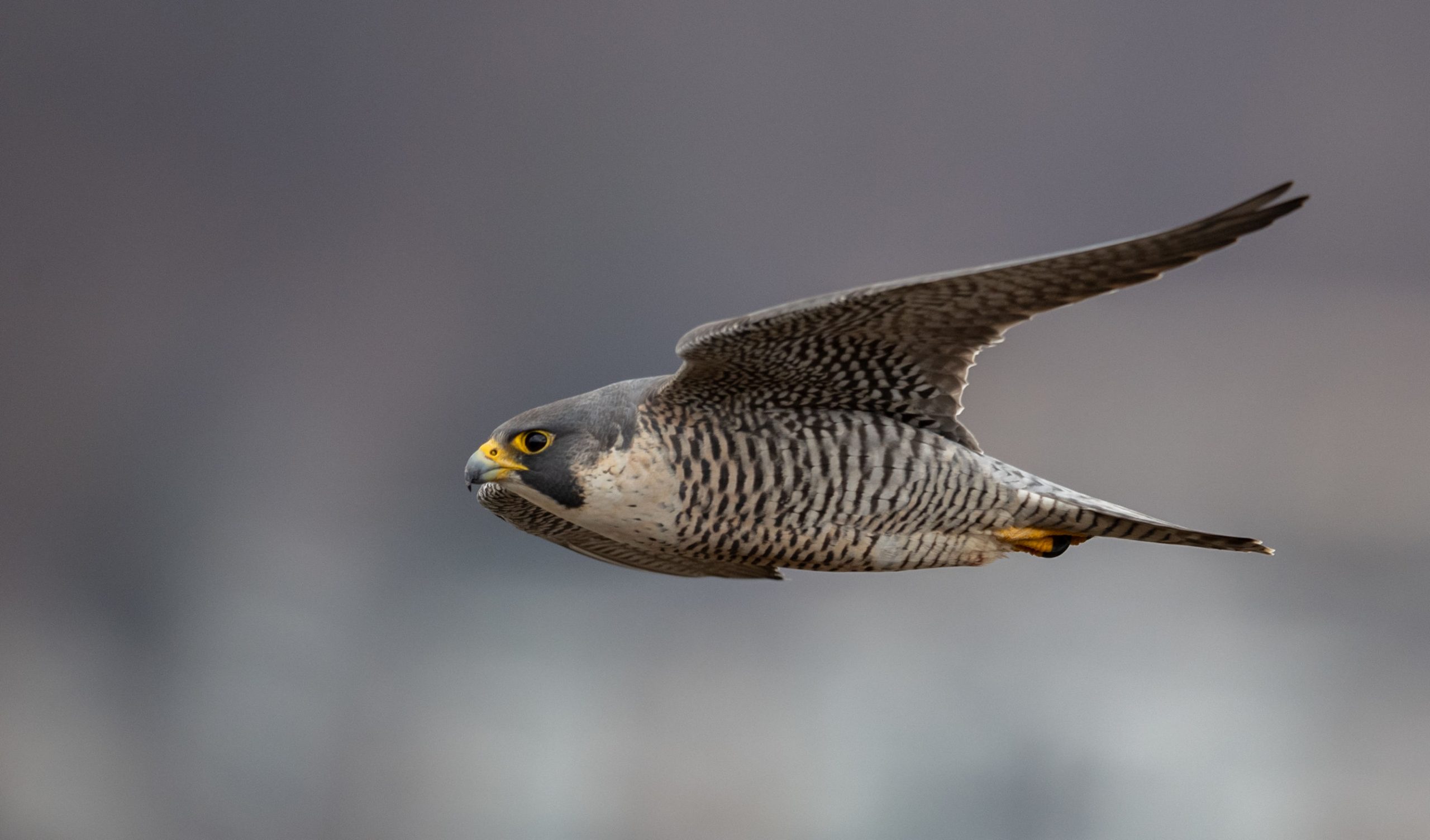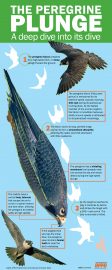Peregrine falcons use speed to feed

For OPPD’s peregrine falcons, every meal begins with a high-speed chase.
The falcons circle up to a few thousand feet overhead, scanning for smaller birds from as far as a mile away. Then they dive, tucking their wings and tail tight in a maneuver known as a stoop. Faster and faster they fall, reaching known speeds of more than 200 miles per hour, as illustrated in the infographic below.
Moments later, they smack their prey with crushing force. The prey birds that don’t die instantly are usually knocked unconscious, rendering them helpless against the falcon. A sharp tomial tooth in the falcon’s beak snaps their neck.
“It’s definitely something they’re known for,” said Chris Vrtiska, a wildlife natural resource specialist at OPPD. “You never see the falcon. You just see a pigeon explode in the air.”
Falcons are the world’s fastest animals, the avian equivalent of a fighter jet, and two of Nebraska’s live on a stack at OPPD’s North Omaha Station.
Lewis and Clark were born in Lincoln in 2012. Clark made her home in the nesting box in 2015, and Lewis joined her later. The falcons have gained an online following via OPPD’s falcon webcam, and they’re also popular on a Facebook page, Peregrine Falcons Lincoln Ne, which follows them along with other area raptors.
Along the way, Lewis and Clark have hatched and raised chicks and fed all of their offspring with their natural hunting skills.
Here’s a look at what they can do.
The need for speed
Every part of a falcon is built for dive-bombing.
A bony growth in their nostrils curves fast-flowing air into a spiral, slowing it down so the falcons can breathe normally while slicing through the sky breathtaking speed.
A special membrane slides over their eyes, spreading moisture and clearing debris that might build during the plunge.
With their wings tucked and tail streamlined, falcons minimize aerodynamic drag that would otherwise slow their descent.
Falcons will venture as far as 12-15 miles from their homes when they hunt, especially when nesting and feeding their young.
They generally eat smaller birds, whatever is available in their area. Around Omaha, pigeons are the most common dining option, Vrtiska said. The falcons may also snack on small ducks and starlings.
Falcons can fly as high as 3,500 feet before beginning their stoop toward prey, and superior eyesight lets them spot prey from more than a mile away.
Few homes in Nebraska
Lewis and Clark aren’t the only falcons in Omaha. WoodmanLife Tower and the Mutual of Omaha headquarters building also have falcon boxes. The Nebraska Capitol in Lincoln also has a box designed for falcons; Lewis and Clark were born at the Capitol. Some have been spotted there this year, but it doesn’t appear that any are nesting right now.
Peregrines aren’t particularly common in Nebraska because they often live on sheer cliff faces, said Joel Jorgensen, nongame bird manager for the Nebraska Game & Parks Commission. In the United States, falcons generally nest in the Appalachian Mountains, East Coast valleys, the upper Mississippi River Valley and the Rocky Mountains, according to the National Park Service.
Falcons are sometimes used to chase away birds that are considered a nuisance or a safety risk around places like airports and farms, Jorgensen said. Specially trained falconers spend years learning how to work with the raptors to hunt.
Seeing a peregrine falcon hunt is a thrilling experience.
“It’s pretty exhilarating,” Jorgensen said.


Grant Schulte joined OPPD as a content generalist in 2022. He is a former reporter for The Associated Press, where he covered the Nebraska Legislature, state politics and other news for a global audience. He is a graduate of the University of Iowa and a proud Hawkeye. In his free time he enjoys running, reading, spending time with his wife, and all things aviation.
View all posts by Grant Schulte >







